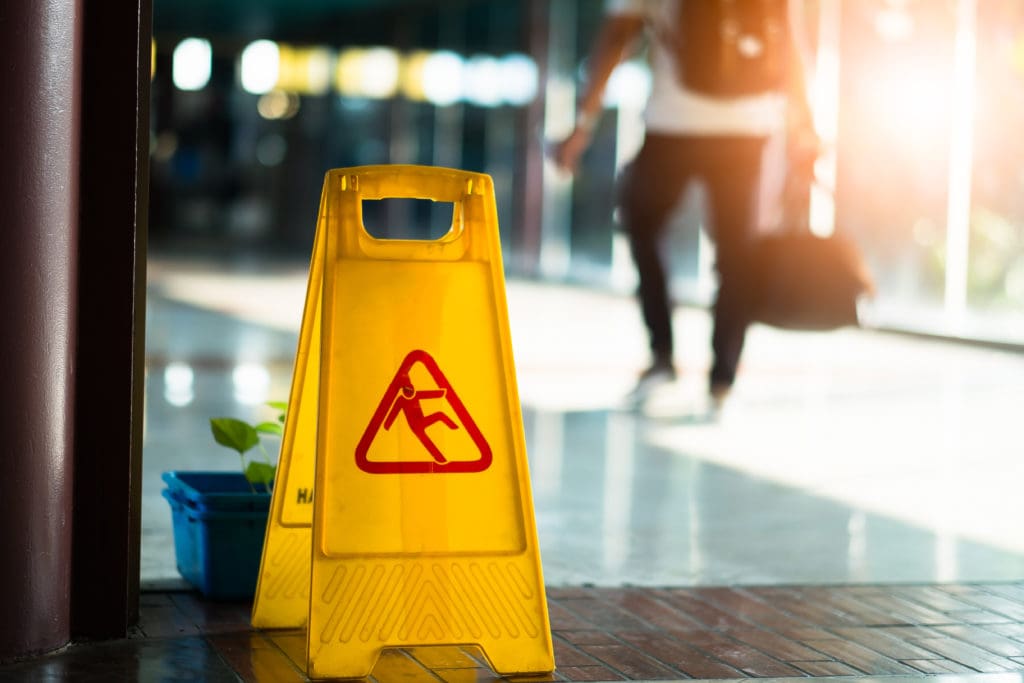The Slip and Fall
Some Slip and Fall Examples


Let’s take a situation where a customer walked into a produce section and picked up a pack of strawberries. He drops a strawberry on the floor. Then, five seconds later, another customer slips on it and falls and injures himself. Well, is the store liable? No, because it’s not a condition which the store created, nor did the store have time to discover and remedy it.
Another example about the conditions which the land occupier created could be cleaning the floors. Perhaps the floors were cleaned with wet soap and they were not properly dried, or they were left out to dry on their own.
In this case, it’s a dangerous condition which was created, again, by the store occupier or by the business occupier. If the owner was aware of this, they should have put warnings about it and made sure that somebody or some indicator was present there to direct customers away from the dangerous area. They’re liable if somebody fell there.
Of course, if there are proper warning signs and somebody disregards them, it might be a contributor of negligence, and once again it’s their fault.
Let’s say we had a flood in a restroom caused by an employee trying to fix a sink. And then he couldn’t fix the sink and caused a flood. He then put a big “Wet Floor” sign at the entrance and put some tape blocking off the entrance. If somebody still got in and injured themselves there was sufficient warning for them to be on notice of a dangerous condition, so they were a contributor in negligence and the claimant takes nothing.
Assumption of Risk
Another situation similar to contributor in negligence is assumption of risk. An assumption of risk is also something which can prevent a claimant in a personal injury case from being able to obtain recovery. Assumption of risk is when there’s a known dangerous condition, and the person goes in there anyways and injures himself.
So if the person knows something is dangerous and still enters, then it’s on them, not on the people who left the dangerous condition.
Let’s say it was a wet floor, and there was a “Wet Floor” sign. Walking right past the “Wet Floor” sign was an assumption of risk. If you knew there is a risk, and yet you still chose to take it, that’s on you, not on the property owner.
And it can be less clear cut, such as if there is no sign, but the condition is obvious. It could be a big, bright pink spill, and the person sees this, but continues to walk through it. They assumed the risk. They knew it was there, and they should have been more careful.
Let’s say it was a wet floor, and there was a “Wet Floor” sign. Walking right past the “Wet Floor” sign was an assumption of risk. If you knew there is a risk, and yet you still chose to take it, that’s on you, not on the property owner.
And it can be less clear cut, such as if there is no sign, but the condition is obvious. It could be a big, bright pink spill, and the person sees this, but continues to walk through it. They assumed the risk. They knew it was there, and they should have been more careful.
Actual Notice
A second type of premises liability is a condition not created by the store or the business owner, but a condition which was created by somebody else, and was known to the store owner.
Let’s say a customer caused a big spill and told the store manager about it. The manager walked out, saw the spill and did nothing about it, and somebody fell. The store manager had an opportunity to remedy it but in this case, the store is liable, and that’s called “actual notice.”
If somebody has actual notice of the dangerous condition on their premises, they are liable for the consequences of that condition.
A Different Situation
Some things are foreseeable in different ways. Let’s say you have a broken refrigerator which is leaking. While it’s foreseeable, the leak will cause a spill. Even if they didn’t know at any given point the spill had existed, let’s say they clean it up every half an hour. Well, it’s foreseeable that the spill will reemerge quicker than that. So when the defective condition is not actual water on the floor which causes the injured party to fall, but the refrigerator leaking itself. And if they knew about that, they should have known about the potential for water being on the floor.
And that’s also relevant in cases if somebody falls in a parking lot outside of a building on ice, because a lot of times, it’s foreseeable.
If you have water draining from the roof, an ice patch could form where it’s draining. So the owner of the building doesn’t need to know that there is ice right there when somebody slipped on it, what we need to know is, “Hey, this is where our drainage comes down, this is how it freezes, this is how people fall,” or, “This is where people can fall.”
Even if they don’t know about the condition which caused the exact fall, they know about the potential for development, and therefore they should have done something about it. They should have inspected the area, and put sand there. They should have identified their problem areas.
